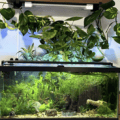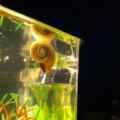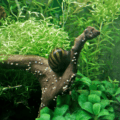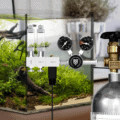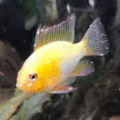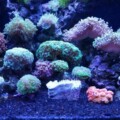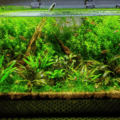Feeding your Siamese Fighting fish the right amount and type of food is crucial for its overall health and well-being. Overfeeding can lead to various complications, including digestive issues and a bloated belly. In this comprehensive guide, we’ll explore everything from live and frozen treats to pellets and flakes, and provide a sample feeding schedule to ensure your pet remains healthy and vibrant.

With practice, I’ve also learned that I need to know how often to feed my Betta fish each week for optimal results. Adhering to the best types of food and an adequate feeding schedule is crucial for avoiding the following myriad of complications in Bettas:
- overfeeding;
- digestive issues;
- a bloated belly or body.
But how many times per day should you offer food to your pet fish and can you occasionally skip giving it a meal?
Could it be that giving live and frozen treats to a Betta more often is better than letting it stuff its face with pellets on the regular?
Let me share with you some reliable tips on feeding frequency for Betta fish and help you take proper care of your new pet.
Let’s dive in!
How frequently should you feed a Betta fish?

When deciding how often to feed your pet Betta, you should consider the fact these fish are opportunistic feeders in the wild.
In other words, they will eat as much as they can.
This explains why you shouldn’t trust your Betta’s huge appetite, as it will mislead you to overfeed the fish, which isn’t good for your pet’s health.
Furthermore, adding too much uneaten food to the aquarium can overwhelm its biofilter with organic waste. This can lead to ammonia spikes that can be detrimental to all aquatic life inside.
That being said, here’s how often to feed your Betta fish for optimal results in the long run:
Betta fish should be fed small volumes of food once or twice a day. The volume of each meal should be equal to the size of the fish’s eyeball. Some experts recommend skipping a feeding day once per week to give your Betta’s digestive tract time to clean out and work properly.
Some aquarists would suggest feeding a mature Betta twice a day but that depends on the stage of your Betta’s development and the aquairum’s temperature.
Through my experience, I’ve found that if your betta is not currently growing and has already reached its adult size of about 2.5 inches (6.4 cm) feeding once daily works better for preventing health issues.
Aquarium temperature, on the other hand, has an effect on how fast your betta’s metabolism works. The warmer the water – the faster the metabolism of your pet fish. During the hot summer days, you’d want to feed your betta twice or even three times a day (small portions!), but in winter, one feeding a day could be enough.
In my case, when only feeding it once a day, my mature fish remains more energetic. When the weather gets warmer I would maybe feed it two times per day once or twice a week, but the rest of the week will be single feeding sessions. Ever since I’ve established this meal schedule for it, my Betta fish have never been bloated or constipated.
Furthermore, I find it more convenient for everyone involved.
Why should the volume of the food be as much as the Betta’s eyeball?
There’s something important you should know when establishing how much food you’re supposed to give to your Betta.
There’s a common belief among fish keepers that the amount of food given to a Betta should resemble the volume of its eye.
Exceeding this amount will overwhelm your Betta’s digestive system, which can become harmful with time. With that out of our way, I consider it essential to go over staple Betta foods and treats that will keep your pet strong and beautiful in the long run.
What are the best foods for a Betta in the long run?
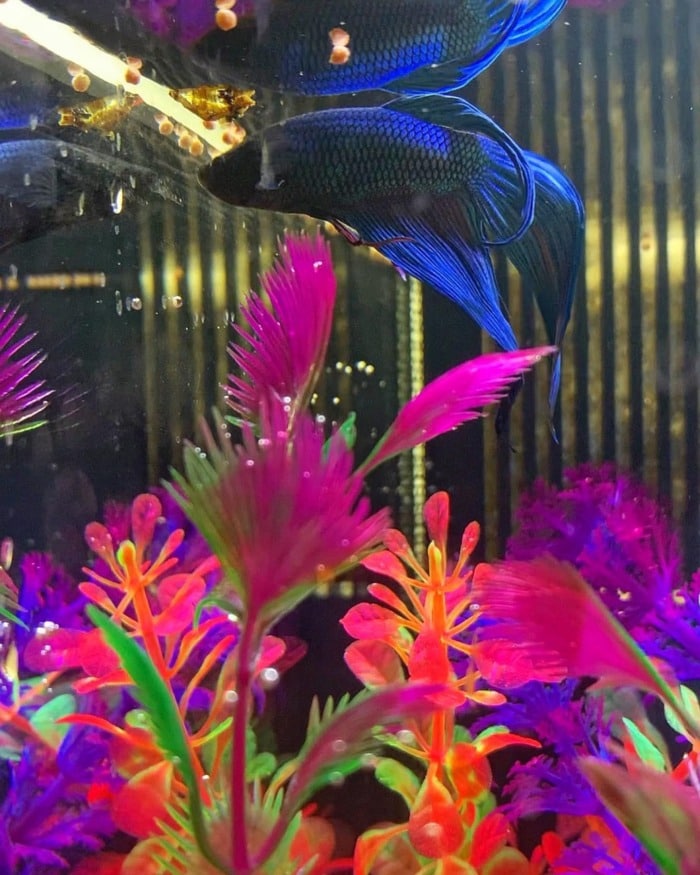
Bettas are strict carnivores and their digestive tract has evolved to break down meat and fiber from the chitin exoskeletons of insects and other invertebrates. This is the reason you may have heard that it’s not a good idea to put a Betta with small shrimp in the same tank.
Ideally, it’s best to give your Betta food that closely resembles what the fish would eat in the wild. This would include:
- bloodworms
- daphnia
- mysis shrimp
- brine shrimp
Here’s a list that explains what would be the best foods and treats for your Betta in the long run:
Feeding live foods: Bloodworms, Daphnia, Brine shrimp, Mysis shrimp

While live foods are the best and most nutritious food options for your Betta, it can be somewhat hard to get them regularly.
You should have a trusted live food source, or use kits for hatching brine shrimp or daphnia at home.
Still, I recommend trying to include these types of meaty foods as a staple in your Betta’s diet.
A diverse diet consisting of these types of food is very likely to keep your Betta healthy in the long run. Furthermore, as a result, its colors would get much brighter and more intense, enhancing its beauty.
That’s because bright colors in fish generally mean that the fish is healthy and therefore ready to take on a fight or mate.
Author’s Note: Feeding your Betta Tubifex worms as an occasional treat isn’t a bad idea as well, even though they aren’t part of the fish’s diet in the wild. Just make sure you get them from a reputable vendor.
Feeding Bettas with frozen foods
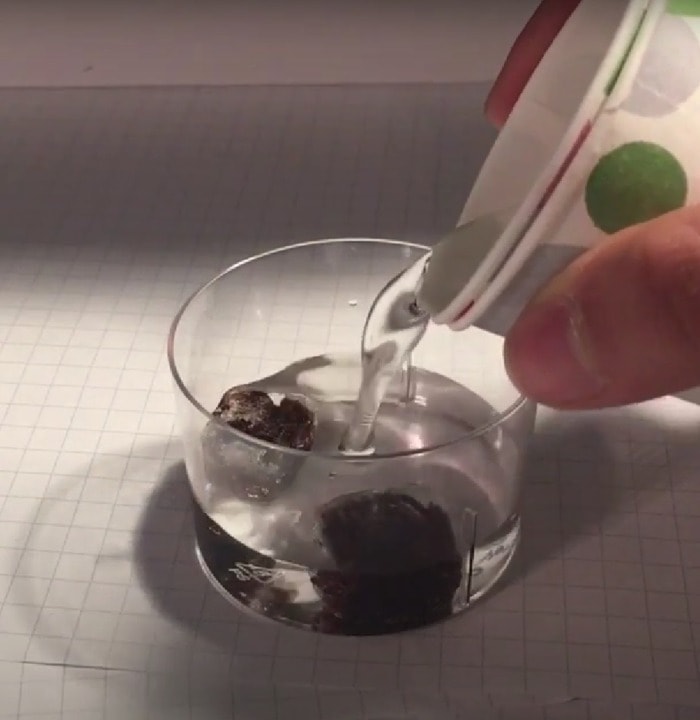
As a great and more convenient alternative to live foods, you can get frozen bloodworms, daphnia, or Mysis shrimp cubes.
To use them, you should:
- Take a cube out of the freezer.
- Chip off the appropriate amount for a Betta meal.
- Let it thaw in a cup with aquarium water for about 30 minutes.
- Feed it to your fish.
You can put the rest of the food cube back in the fridge, conserving it in a ziploc bag or a small sealed container.
Once thawed and returned to the fridge, the Betta food cube can be used for the following 5 to 7 days.
I mainly use these frozen meaty foods to feed my Bettas.
Once or twice a week I’d treat my buddies to a portion of live food.
Feeding Betta fish freeze-dried foods

Freeze-dried foods are another way to provide your Bettas with protein and the right kind of fiber.
The thing is that during processing, these foods are stripped of their water contents.
This prevents harmful bacteria or parasites from contaminating them because life needs water.
Freeze-dried foods can be slightly harder to digest for the fish if not thawed properly.
Contrary to popular belief among fish keepers, there’s nothing wrong with feeding your Betta these in the long run.
Anyway, freeze-dried Betta foods should be soaked in water for about 30 minutes before adding them to the fish tank.
This way you will ease your fish’s digestion and avoid swollen belly and constipation.
Feeding Bettas pellets should be done in moderation
There are, in fact, pellets of higher quality that you can use to feed your Betta fish. Such pellets are the ones by New Life Spectrum or by Omega One Betta Buffet.

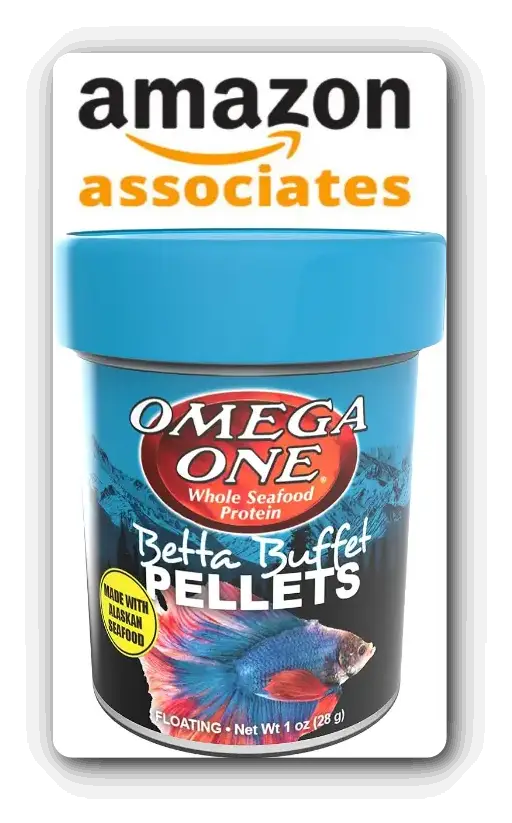
Nevertheless, I don’t recommend feeding your Betta pellets every day.
On one side pellets contain highly processed protein, coming from a source that isn’t part of the natural diet of the fish.
On the other hand, the fiber they contain doesn’t come from insects, but from other sources such as peas and wheat flour.
Plant fibers aren’t natural for your Betta’s digestive tract either.
With that being said, most Betta keepers use pellets for their captive-bred specimens, which I don’t necessarily agree with.
Author’s note: Even though there are high-quality pellets on the market, most of them contain gluing agents and grains that may harm your Betta’s digestive system in the long run. For this reason, I recommend giving pellets to your Betta fish no more than twice a week, with the rest of the days offering different kinds of foods.
Offering tropical fish flakes to your Betta
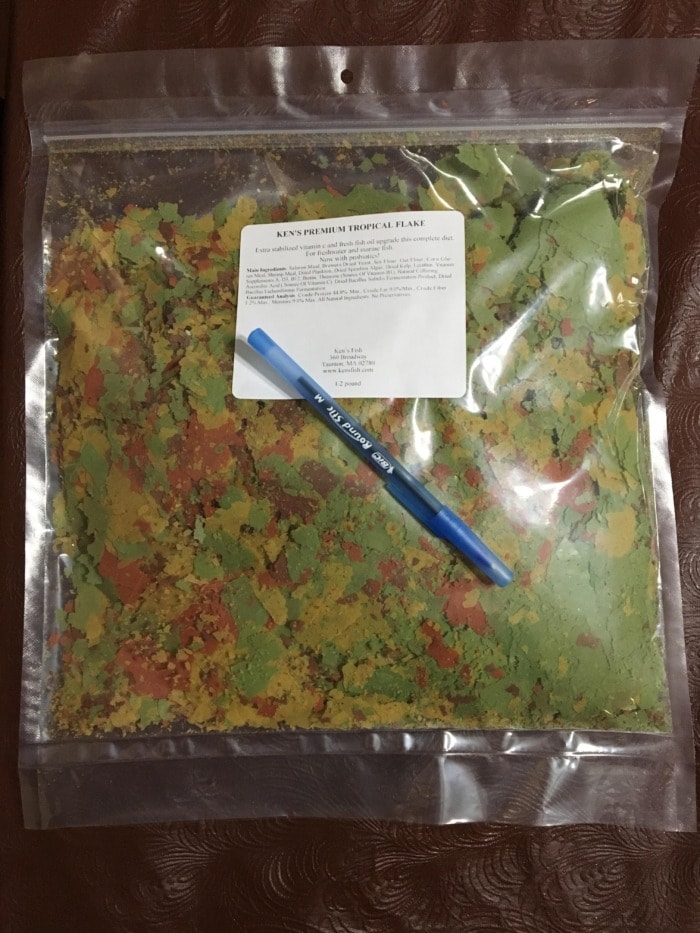
I don’t recommend using flakes to feed your Betta, as they don’t carry a lot of nutritional value for your pet. Furthermore, they tend to make a mess in the aquarium water, which can sometimes turn green as a result.
With that being said, if you have a community fish tank, it isn’t a big deal if your Siamese fighter bites off pieces of the tropical flakes you give to the other fish. Try to target feed its tank mates and stay away from giving the Betta fish tropical flakes intentionally.
Feeding Bettas human food and other homemade meals is not recommended
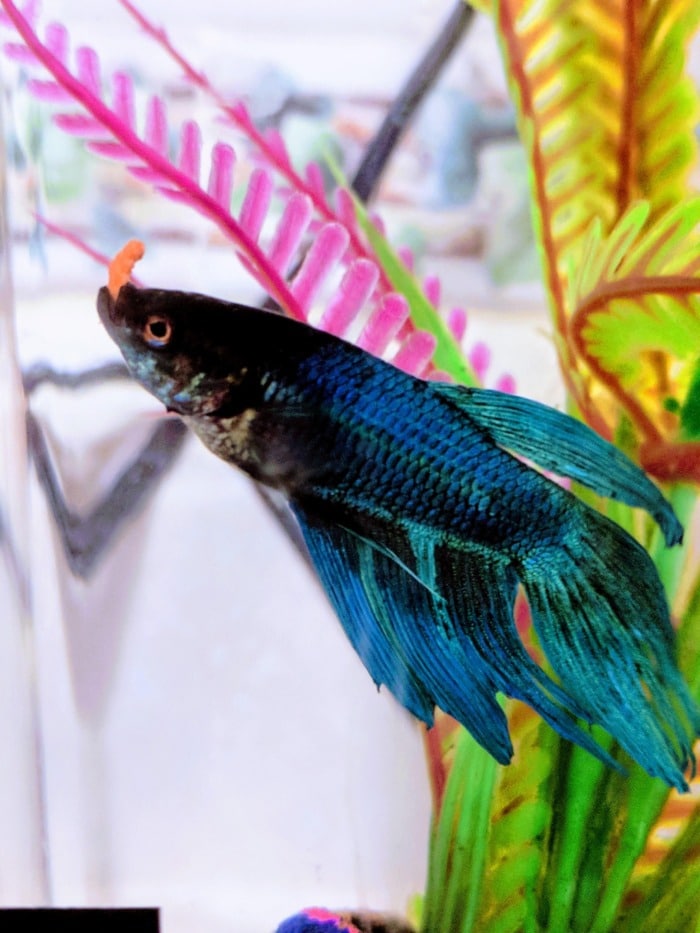
Some people suggest that you can improve your Betta fish’s digestion by giving it a chopped bit of boiled peas or cucumber.
Nevertheless, this source of fiber isn’t going to benefit a carnivorous Betta that much. When I want to add more fiber to my Betta’s diet, I rely on Mysis shrimp or Daphnia.
Other aquarists would give their Bettas pieces of Walmart-bought salad shrimp, canned crab meat, and leafy greens such as spinach.
While your Siamese Fighting fish will gladly eat some of these human foods, I don’t recommend including them as a regular part of your pet’s diet.
Trying to come up with any homemade food for a wild insectivore such as the Betta is risky. Homemade human foods are not something a Betta could eat on the regular safely. These foods have a different source of fiber and protein than what the body of the Betta is manufactured to process. Don’t risk it unless you don’t have anything else to offer your fish at that moment.
What’s a good example calendar for a Betta feeding schedule?
Considering the food recommendations above, you can play around with the different options to provide your pet fish with a diverse diet.
Here’s a good weekly schedule for feeding an adult Betta:
- Monday: Live, frozen or freeze-dried Bloodworms or 2 to 3 high-quality pellets, once or twice a day.
- Tuesday: Live, frozen or freeze-dried Bloodworms once a day.
- Wednesday: Live, frozen or freeze-dried Daphnia once a day.
- Thursday: Live, frozen or freeze-dried bloodworms or 2 to 3 high-quality pellets, once or twice a day.
- Friday: Live, frozen or freeze-dried Mysis shrimp once.
- Saturday: Skip Feeding.
- Sunday: Live, frozen or freeze-dried Daphnia, once or twice a day.
As you see, the fasting day comes after the day I’d feed Mysis shrimp.
The latter is very rich in fiber, which is ideal because your Betta’s stomach would take longer to digest the meal.
Also, don’t worry about not feeding your pet fish.
In the wild, Betta fish don’t get to eat to a full belly every day, as in nature the food isn’t always available. Actually, a healthy Betta can go without food for up to two weeks, so skipping a day of feeding is totally safe for it.
What issues could arise when feeding a Betta?
If your Betta is not eating as per usual, and has lost its appetite, then you may need to take a closer look at its health. In such scenarios the fish is likely stressed from something in its environment. More often than not, the stress would be from a sudden shift in the water’s parameters.
Another thing that should not be overlooked is overfeeding your betta fish.
On one side, overfeeding can lead to issues like belly bloat and overwhlemed intestines in Betta fish. Although possible if you know what you’re doing, once these issues occur it can be very difficult to reverse the damage.
On the other hand, overfeeding your Betta can lead to uneaten fish food that sinks to the bottom of the tank. Even with regular cleaning of the substrate, some particles can remain there and start to rot. This releases toxins in the water and is dangerous to your Betta.
As a recap – feeding the right amount and with the right frequency can spare you and your Betta a lot of troubles.
How often to feed a baby Betta?

Baby Bettas should be fed with nutritious foods such as baby brine shrimp and microworms twice a day.
After the second month, you can add frozen daphnia, brine, or Mysis shrimp to the fry’s menu.
You shouldn’t give your young Siamese Fighting Fish baby pellets before it reaches 3 months of age.
After that, you can safely include them as part of the Betta’s diet.
Author’s note: Some breeders would raise their Betta fish on flakes so that it doesn’t refuse to eat pellets in the future. Even though this practice makes feeding the Betta easier, it can hinder the fish’s development and its overall well-being in the long run.
How frequently should you feed breeding Bettas?
When breeding, Bettas need to be at their best with all the gill flaring, wooing and procreating. If you’re trying to breed Betta fish you should feed them twice a day, without exception. Even three feeding sessions per day are not uncommon for breeding Bettas.
Their bodies need the extra energy for the mating ritual.
Moreover, sometimes male Betta will stop eating for days while guarding their bubble nests. For the adult male to remain healthy during this period it needs to be well fed beforehand.
My closing thoughts
Feeding your Betta too much and too often can be bad for its health.
If in doubt, you could follow my weekly feeding schedule.
Some people prefer splitting the meal in two and feeding their Bettas twice – once in the morning and once in the evening.
To be fair, as long as you take the meal’s size into consideration, and provide your Betta with a good diverse diet, you’re good to go.
Leave me a comment below if you have any questions!

